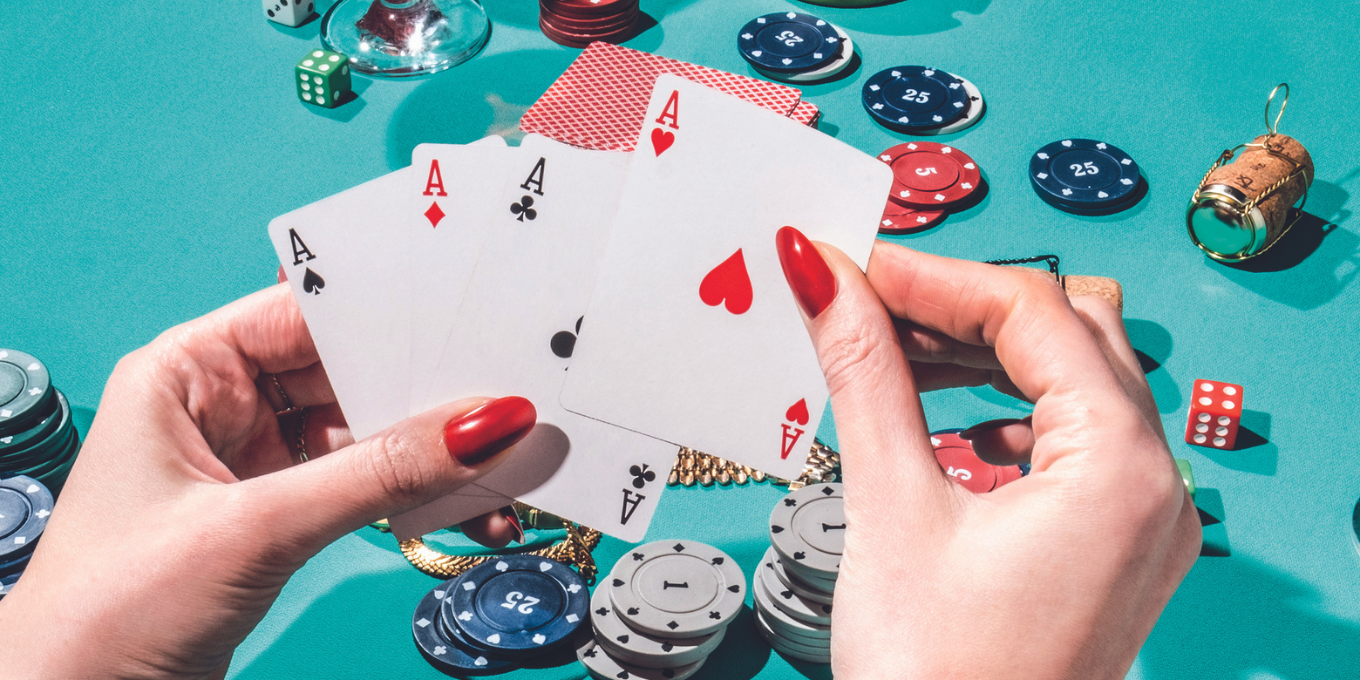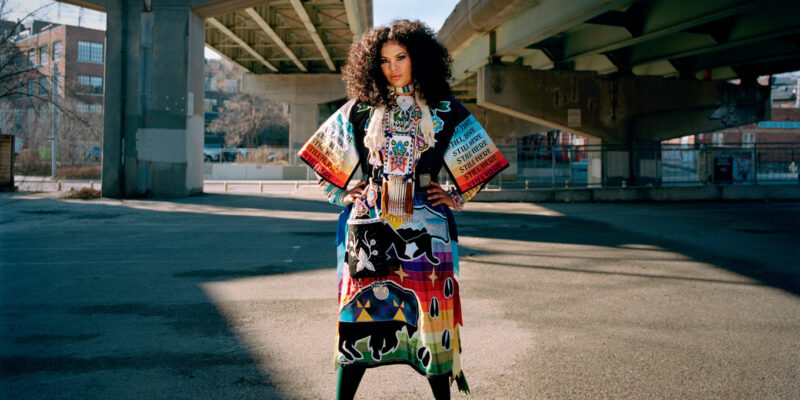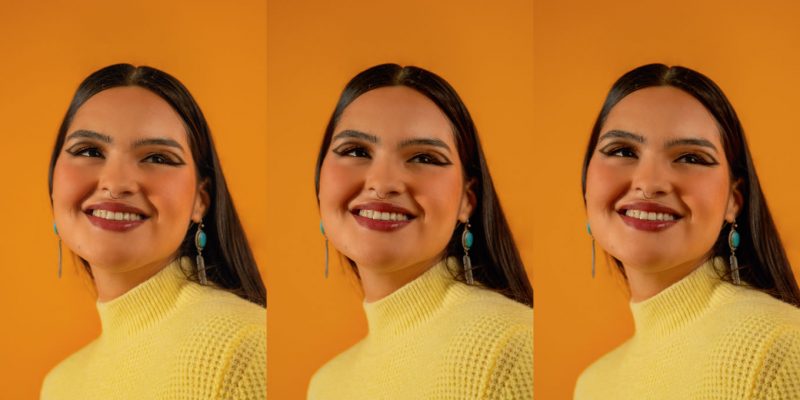Society
Professional Poker Has Always Been a Boys Club—Not Anymore
Time for a wild card.
by : Melissa Vincent- Jun 20th, 2023

COLLAGE, STOCKSY/AUDSHULE
My reaction to one of the first questions I’m asked at the PokerStars European Poker Tour (EPT) tournament categorizes me as an easy mark. Amid fire dancers and bottles of cava at a lavish Barcelona beach club, Chris Reed, one of a handful of female players at the event, looks me straight in the eye and earnestly asks, “Who are you railing here?”
I gaze at the cigar-box purse—which is designed to look like the ace of spades—in the crook of her arm while she studies my face. She clocks my wordless expression and then clarifies without missing a beat: “I mean who are you cheering for?” Reed’s adjustment gives me a quick introduction to one of the defining hallmarks of poker pros: the ability to read other people. If you have an unguarded face—as I learned I apparently do—you’re toast in this game. A slight twitch of the mouth, an unintentional eyebrow furrow or a few blinks in rapid succession are all possible “tells” as to whether what you’re saying is true.
“Poker has given me amazing camaraderie and friendships with women all over the world, and there’s one thing we have in common,” Reed later says at the rooftop bar at Barcelona’s Hotel One. “There are very few wallflowers who play poker.”
Card games that involve highly skilled astute players, the potential for a massive payday and an element of luck have long had a hold on our cultural consciousness. But historically, it’s been a million-dollar boys club. In August of last year, online poker behemoth PokerStars held its first women’s invitational in an attempt to incentivize more women to play. Although women’s events are no longer new in the world of competitive poker, the motivations of the growing number of women who find themselves wrapped up in the game often buck popular assumptions.
For one, it’s not always about the money. “Poker doesn’t really give you economic security unless you do it professionally, so it takes some time to get there,” says EPT tournament winner Giada Fang, who has an academic background in medicine and surgery and now splits her time between being an on air host for a poker television show and translating poker books into Italian. She started playing online while she was recovering from a serious motorbike accident 12 years ago in Italy; her foray into the game was on the heels of an international poker boom in the early 2000s. For the first time, high-stakes tournaments were being broadcast on national television, which resulted in box-office blockbusters—like the Ocean’s Eleven remake and Casino Royale—that glamourized the game, and the general public got a front-row seat to huge wins by underdog amateur players (including Jennifer Harman, who, in 2000, became the first woman to win a coveted World Series of Poker bracelet, widely considered the most prestigious non-monetary prize a player can win). All this contributed to a surge in the game’s popularity, evidence that the old guard was changing. (A few years ago, Maria Konnikova’s The Biggest Bluff, which traces the lessons she learned following her introduction to the world of poker, became a New York Times Best Seller.)
Today, a collision of factors—including the option to play from anywhere using a smartphone, the possibility of funding via cryptocurrencies and the multi-dimensional immersive gameplay available on e-sports platforms like Twitch—has given the global poker market an estimated valuation of $76 billion, with projections that it could reach $170 billion by 2030. Thanks to a 1985 amendment to the Criminal Code that gave provinces exclusive control over legalized gambling, Ontario’s Ford administration was able to open up a regulated online gambling market, which has brought everything from sports betting to online poker into our collective line of sight through inescapable advertisements on billboards, Jumbotrons and city buses. Though a 2022 study by Statistics Canada reported that the majority of players are not at risk for developing a gambling problem, past studies have revealed a higher likelihood for addiction in low-income populations, although they largely didn’t examine additional factors like formats of play, environment or gender. One of the last major studies examining problem gambling among Canadian women was conducted in 2010 by The Canadian Journal of Psychiatry; in it, the study authors advocated for significant additional research in the realm of internet gambling to evaluate its short- and long-term impacts.
Historically, poker has been imperfect, and it remains knotted with complex issues, with only a small fraction of players winning at or even aspiring to play at a high level. For most, cultivating a distinct style of play within an ever-growing international community is what gets them to the table, both virtually and IRL. According to a 2021 study by The Journal of Gambling Business and Economics, even though women make up roughly 30 percent of players in the online poker space, a scant 3 to 5 percent end up in live rooms at casinos. The same study revealed that the live room has not been immune to things like the archaic positioning of women as bartenders or floor runners and inappropriate behaviours—both on and off the table.
“It’s kind of the same conversation [being had] about the Formula 1 girls: How do you appeal to women if the only way they’re being represented is through being on the sidelines and waving a flag or giving a man a trophy?” asks Rebecca McAdams Willetts, director of partnerships, PR and consumer engagement at PokerStars, who, through her role, launched a women’s poker boot camp and used player feedback to make changes to timing, buy-in and prizes. “Industry-wide, there is a huge movement to engage women in a more intelligent and respectful way. Most of the time, what we hear is that women don’t have [expendable leisure] time and have to prioritize how they spend their money. If women have any downtime, they have to decide between poker and a series on Netflix or catching up on life admin or sleeping because they’ve been up all night with the baby.”
“These are the talents I developed as a 19-year-old stripper, so when I found poker, it was a perfect match. But at the time, I didn’t realize how valuable that skill set was.”
While poker might scratch an entertainment itch, it also has a hidden knack for fostering skills that are transferable to other parts of life. Playing on a circuit helps with financial- planning and budgeting knowledge, which is needed to manage a bankroll (the amount of money a player sets aside to pay with), and there’s a growing crop of self-improvement programs, like Poker Power, that invite seasoned female players to teach other women skills like “intelligent decision-making, negotiation tactics and opportunity identification through risk assessment,” which can be used everywhere “from the classroom to the boardroom.”
These types of workshops didn’t exist when Ebony Kenney started developing the tools that would give her the coveted edge that led to her becoming one of professional poker’s most compelling breakout stars and earning a spot in the record books when she cashed out at $1.7 million at the Coin Rivet invitational in northern Cyprus last fall. (It was a highly visible televised win, and she intentionally wore clothing and a head wrap by Black-owned brands Fanm Djanm and Öfuurë.) While studying engineering as a single mom, she started working as an exotic dancer because it aligned well with her busy schedule. “I developed the ability to read people through body language and by noticing patterns,” she explains. “I could tell right away who had money and who didn’t. I knew how to handle men being aggressive or out of line. These are the talents I developed as a 19-year-old stripper, so when I found poker, it was a perfect match. But at the time, I didn’t realize how valuable that skill set was.”
However, a barrier exists for promising female players—who still comprise only five percent of those on the professional-poker circuit—when they try to make their way to the next level: Backers that front the money to enter higher-stakes tournaments are harder to come by. “People don’t put enough trust in women,” says Fang, noting the disparity between the way male players are funded compared to women with a similar skill level. For Kenney, getting sponsored by America’s Card Room was a game-changer that gave her more time to play and study, enabling her jump from mid-stakes playing into the upper echelon. “Even though my kids are 18 and 21, I want to fully take care of them because for so long in their lives, there was so much uncertainty and waiting for the other shoe to drop,” she says. “I’m at this point in my life now where I’m like: ‘Chill out, kids. Sit back and take it all in. Mom’s got it.’ Now I don’t have to rely on whatever guy I’m dating to pay the bills and go through that emotional tug-of-war.”
In writer Jason Reynolds’ four-part podcast series for Radiotopia, My Mother Made Me, he recounts how on a trip to the casino with his mom—a pre-lunch Sunday ritual for as long as he can remember—her motivation for playing clicked for him when she revealed that the slots taught her to “keep her feet on the ground.” McAdams Willetts feels the same way. “Poker players have to forgive themselves so much,” she says. “You get used to saying ‘Well, in that moment, I made the right decision; I couldn’t have known what was going to happen next.’ Then you just move on instead of getting stuck.”
When Kenney reflects on her 15-year career, she credits her approach to poker with helping her on a larger healing journey. “For a long time, I really thought [my reality] was just feast or famine,” she says. “I didn’t realize that [I could find] a consistent middle ground. Now I’m able to be a lot more gentle and compassionate with myself and with other people. Poker is a microcosm of life. If you zoom out, it’s such a big representation of what life is—and can be.”
If you or someone you know has a problem with gambling and needs help, visit the Canada Safety Council’s website for a full list of problem-gambling hotlines across the country.
Newsletter
Join our mailing list for the latest and biggest in fashion trends, beauty, culture and celebrity.
Read Next

Fashion
Bella Hadid Glows in a Strapless Lace Dress With a Sheer Corseted Bodice
Hadid was also seen that same day promoting her new fragrance brand ‘Ôrebella.
by : Briannah Rivera- May 3rd, 2024

Fashion
This Year’s Indigenous Fashion Arts Festival Is Sure to Impress
"Creating an opportunity for us to work collectively—prioritizing language and tradition—is of the utmost importance. Our similarities are inspired and shaped by the legacies left to us by our ancestors.”
by : Kelly Boutsalis- May 3rd, 2024

Beauty
This Exfoliating Serum Creates a ‘‘New Skin’’ Effect
Say hello to smooth, radiant skin.
by : ELLECanada.com- May 2nd, 2024




